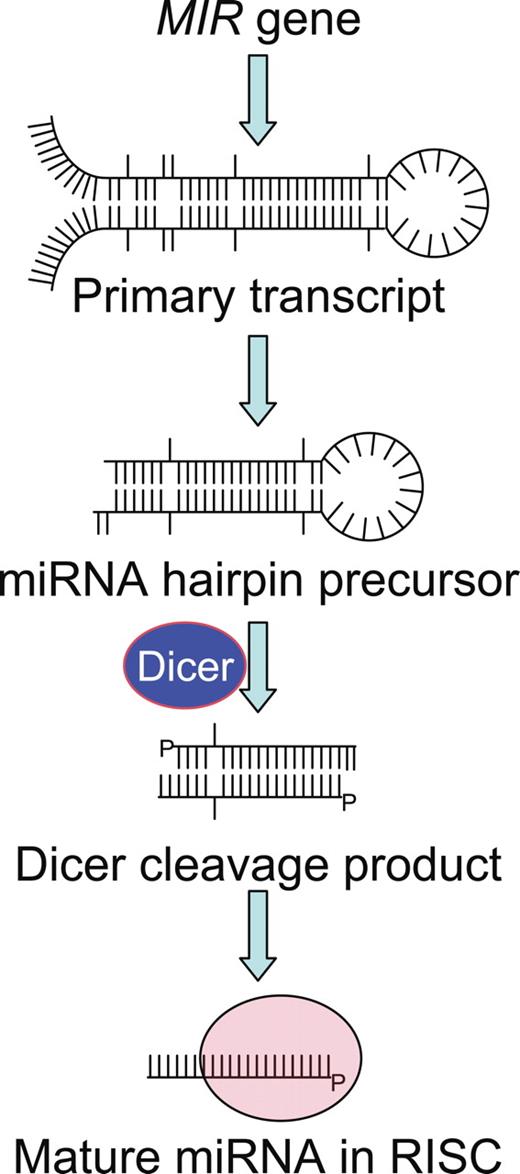In this issue of Blood, Raveche and colleagues provide evidence that the dysregulated expression of a single microRNA can factor in the development of neoplasia.
MicroRNAs are a group of small noncoding RNA molecules of 19 to 24 nucleotides in length that can regulate the stability and/or expression of targeted messenger RNA, thereby serving to regulate gene expression.1,2 Each microRNA is transcribed as part of a longer molecule of several kilobases in length, processed in the nucleus into hairpin RNA of 70 to 100 nucleotides, and then transported to the cytoplasm, where it is digested by a highly conserved double-stranded specific ribonuclease called Dicer, and then processed into the single-stranded targeting RNA within an RNA-induced silencing complex (RISC; see figure). Initially estimated to be in the hundreds, the number of microRNA genes identified in the mammalian genome through direct and electronic cloning appears to be well over 1000. Because each microRNA potentially can regulate expression of a distinct set of genes, it is conceivable that the differential expression of different microRNAs might profoundly influence the repertoire of genes that are expressed during development, differentiation, or disease.
MIR genes encode a primary transcript that gets processed into mature microRNA (miRNA), which becomes the targeting molecule in RNA-induced silencing complexes (RISCs) that exert posttranscriptional control of gene expression.
MIR genes encode a primary transcript that gets processed into mature microRNA (miRNA), which becomes the targeting molecule in RNA-induced silencing complexes (RISCs) that exert posttranscriptional control of gene expression.
The first demonstration that dysregulated expression of microRNA might factor in the development of disease was made through the study of chronic lymphocytic leukemia (CLL), a disease characterized by the accumulation of monoclonal CD5 B cells.3 The most commonly deleted genomic region in CLL occurs in the long arm of chromosome 13 at 13q14.3, which undergoes deletion in over half of all cases. Due to this, many investigators have searched for a gene or genes in this region that could factor in the development of this leukemia. Calin et al,3 working on cases of familial CLL in the CLL Research Consortium, identified the smallest region of deletion at 13q14.3 that was associated with CLL. They found that this region did not contain any genes for messenger RNA, but rather 2 clustered genes encoding microRNAs, designated miR15a and miR16–1.3 Although these microRNAs are expressed at high levels in the CD5 B cells of healthy adults, both were found present at only low levels in most cases of CLL (about 70%).4 Further strengthening the model that these 2 microRNAs contribute to leukemogenesis, Calin et al5 identified a CT substitution in the transcript of miR15a/miR16–1 that was associated with reduced expression of these microRNAs and that also was found in some patients with familial CLL, suggesting that this genetic polymorphism possibly predisposes to cancer.
One way in which reduced expression of miR15a/miR16–1 could contribute to oncogenesis is through the consequent dysregulation of genes that are targeted by such microRNAs, such as BCL2. Indeed, the first 9 nucleotides from the 5′ ends of both miR15a and miR16–1 are complementary to bases 3287 to 3279 of BCL2, which encodes a protein that can inhibit apoptosis, or programmed cell death. This protein is abundant in CLL cells and in MEG-01, a B-cell tumor cell line that also has low-level expression of miR15a/miR16–1. Transfection of MEG-01 cells with a vector encoding these microRNAs repressed expression of BCL2 and rendered these cells highly susceptible to apoptosis and less tumorigenic,6 raising the prospect that such microRNAs might have potential for use in cancer therapy.
In this issue of Blood, Raveche and colleagues report on another important facet of this developing story. These investigators examined genes that contribute to the known propensity of New Zealand Black (NZB) mice to develop a CD5 B-cell lymphoproliferative disease that has many features in common with CLL.7 They backcrossed NZB mice with a control strain of mice and found that the development of lymphoproliferative disease was linked to 3 loci, one of which was syntenic to human 13q14. At this locus, they identified a point mutation in the 3′ region flanking the mouse homolog to human miR16–1. This mutation defined a genetic polymorphism in miR16–1 that was peculiar to the NZB mouse and that also resulted in reduced expression of miR16–1 in the lymphoid tissues of these animals. Similar to studies with the MEG-01 human B-cell tumor line, transfection of neoplastic CD5 B cells derived from NZB mice with exogenous miR16–1 rendered the mouse tumor cells more susceptible to apoptosis. Collectively, these studies indicate that abnormal, low-level expression of miR15a/miR16–1 can lead to lymphoproliferative disease of CD5 B cells in both mice and humans. In addition to providing evidence that altered expression of miR15a/miR16–1 is, in fact, the molecular lesion for most cases of CLL, this study also suggests that the NZB mouse might provide a useful model with which to evaluate strategies for correcting abnormal expression of microRNA for the prevention and/or treatment of neoplastic disease.
Conflict-of-interest disclosure: The author declares no competing financial interests. ■


This feature is available to Subscribers Only
Sign In or Create an Account Close Modal